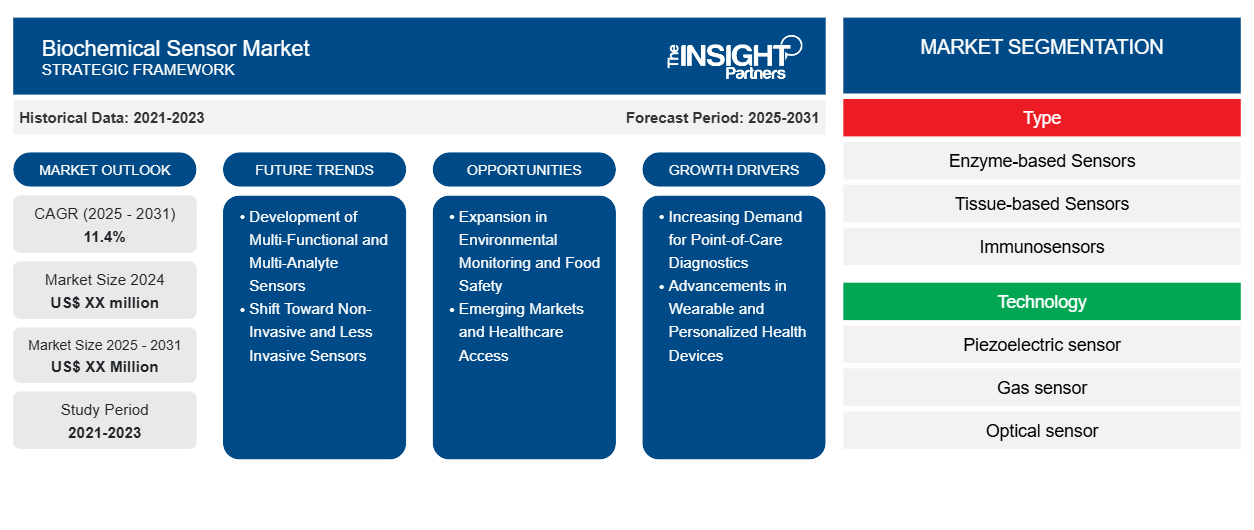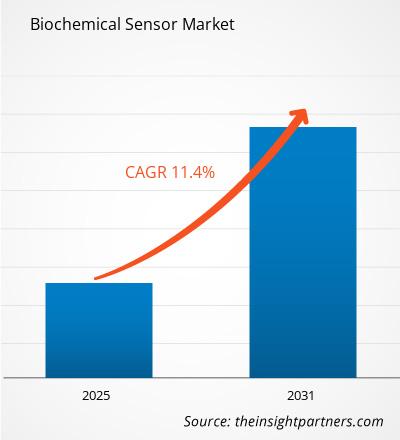Biochemical Sensor Market Share, Size, Trends, and Forecast by 2031
Historic Data: 2021-2023 | Base Year: 2024 | Forecast Period: 2025-2031Coverage: Biochemical Sensor Market covers analysis By Product Type (Electrochemical Sensors, Optical Sensors, Gas Sensors, Thermal Sensors, Piezoelectric Sensors); Film Deposition Material (Titanium Oxide, Fluorine Doped Tin Oxide, Silicon Oxide, Aluminum Oxide, Others); End-Use Industry (Healthcare, Pharmaceutical, Chemicals, Food and Beverage, Military and Defense, Others) , and Geography (North America, Europe, Asia Pacific, and South and Central America)
- Report Date : Feb 2026
- Report Code : TIPRE00014955
- Category : Electronics and Semiconductor
- Status : Upcoming
- Available Report Formats :


- No. of Pages : 150
The Biochemical Sensor Market is expected to register a CAGR of 11.4% from 2025 to 2031, with a market size expanding from US$ XX million in 2024 to US$ XX Million by 2031.
The report is segmented by Type (Enzyme-based Sensors, Tissue-based Sensors, Immunosensors, DNA biosensors, Others), Technology (Piezoelectric sensor, Gas sensor, Optical sensor, Electrochemical sensor, Thermal sensor, Others); Application (Chemical Analysis, Clinical Diagnosis, Environmental Monitoring, Food Quality Control, Security Screening, Drug Discovery, Water Quality Management, Others); End Use Industry (Military & Defence, Food and Beverage, Medical and Healthcare, Water and Wastewater, Chemical, Pharmaceutical, Environment, Others). The global analysis is further broken-down at regional level and major countries. The report offers the value in USD for the above analysis and segments
Purpose of the Report
The report Biochemical Sensor Market by The Insight Partners aims to describe the present landscape and future growth, top driving factors, challenges, and opportunities. This will provide insights to various business stakeholders, such as:
- Technology Providers/Manufacturers: To understand the evolving market dynamics and know the potential growth opportunities, enabling them to make informed strategic decisions.
- Investors: To conduct a comprehensive trend analysis regarding the market growth rate, market financial projections, and opportunities that exist across the value chain.
- Regulatory bodies: To regulate policies and police activities in the market with the aim of minimizing abuse, preserving investor trust and confidence, and upholding the integrity and stability of the market.
Biochemical Sensor Market Segmentation
Type
- Enzyme-based Sensors
- Tissue-based Sensors
- Immunosensors
- DNA biosensors
Technology
- Piezoelectric sensor
- Gas sensor
- Optical sensor
- Electrochemical sensor
- Thermal sensor
Application
- Chemical Analysis
- Clinical Diagnosis
- Environmental Monitoring
- Food Quality Control
- Security Screening
- Drug Discovery
- Water Quality Management
End Use Industry
- Military & Defence
- Food and Beverage
- Medical and Healthcare
- Water and Wastewater
- Chemical
- Pharmaceutical
- Environment
You will get customization on any report - free of charge - including parts of this report, or country-level analysis, Excel Data pack, as well as avail great offers and discounts for start-ups & universities
Biochemical Sensor Market: Strategic Insights

-
Get Top Key Market Trends of this report.This FREE sample will include data analysis, ranging from market trends to estimates and forecasts.
Biochemical Sensor Market Growth Drivers
- Increasing Demand for Point-of-Care Diagnostics: One of the key drivers of the biochemical sensor industry is the increasing demand for point-of-care (POC) diagnostics. Biochemical sensors, such as glucose meters, pregnancy tests, and cholesterol monitors, are frequently employed in healthcare settings to offer immediate, on-site findings. The rising prevalence of chronic diseases such as diabetes and cardiovascular disease, combined with the necessity for real-time health monitoring, is driving up demand for such sensors.
- Advancements in Wearable and Personalized Health Devices: Wearable health devices, such as fitness trackers and continuous glucose monitors (CGMs), are also becoming increasingly popular. These devices include biochemical sensors, which enable real-time monitoring of biomarkers such as glucose levels, lactate, and oxygen saturation. The expanding trend of customized healthcare and preventative medicine is driving demand for such novel, non-invasive sensors.
Biochemical Sensor Market Future Trends
- Development of Multi-Functional and Multi-Analyte Sensors: Multi-functional and multi-analyte sensor development is an important trend, with the goal of detecting many biomarkers or analytes at the same time. This trend enables more complete health monitoring using a single device. For example, some sensors now detect glucose, lactate, and other metabolites, providing patients with a more complete picture of their health while decreasing the need for several devices.
- Shift Toward Non-Invasive and Less Invasive Sensors: One of the key trends in the biochemical sensors market is the shift toward non-invasive and less invasive sensing technologies. Traditional biochemical sensors often require blood or urine samples, but consumers and healthcare providers are increasingly demanding non-invasive options that can measure biomarkers through sweat, saliva, or even the skin. Innovations in transdermal biosensors, optical sensing, and electrochemical sensors are enabling the development of non-invasive or minimally invasive devices. This trend is particularly important for applications like continuous glucose monitoring for diabetes, where non-invasive sensors would significantly improve the patient experience.
Biochemical Sensor Market Opportunities
- Expansion in Environmental Monitoring and Food Safety: Biochemical sensors are gaining popularity for environmental monitoring applications such as detecting pollutants or toxins in air, water, and soil. Similarly, they are used to ensure food safety and quality by identifying pollutants such as pathogens, pesticides, and spoiling indicators. With increased worries about environmental pollution and foodborne infections, the market for biochemical sensors in these areas is expected to develop dramatically.
- Emerging Markets and Healthcare Access: Biochemical sensors have a huge potential for improving healthcare access and monitoring in emerging markets. Many regions are implementing low-cost, portable diagnostic equipment that will allow patients in rural or underserved locations to receive prompt medical care. This increased use in rural and low-resource areas creates new opportunities for biochemical sensor makers.
Biochemical Sensor Market Regional Insights
The regional trends and factors influencing the Biochemical Sensor Market throughout the forecast period have been thoroughly explained by the analysts at The Insight Partners. This section also discusses Biochemical Sensor Market segments and geography across North America, Europe, Asia Pacific, Middle East and Africa, and South and Central America.
Biochemical Sensor Market Report Scope
| Report Attribute | Details |
|---|---|
| Market size in 2024 | US$ XX million |
| Market Size by 2031 | US$ XX Million |
| Global CAGR (2025 - 2031) | 11.4% |
| Historical Data | 2021-2023 |
| Forecast period | 2025-2031 |
| Segments Covered |
By Type
|
| Regions and Countries Covered |
North America
|
| Market leaders and key company profiles |
|
Biochemical Sensor Market Players Density: Understanding Its Impact on Business Dynamics
The Biochemical Sensor Market is growing rapidly, driven by increasing end-user demand due to factors such as evolving consumer preferences, technological advancements, and greater awareness of the product's benefits. As demand rises, businesses are expanding their offerings, innovating to meet consumer needs, and capitalizing on emerging trends, which further fuels market growth.

- Get the Biochemical Sensor Market top key players overview
Key Selling Points
- Comprehensive Coverage: The report comprehensively covers the analysis of products, services, types, and end users of the Biochemical Sensor Market, providing a holistic landscape.
- Expert Analysis: The report is compiled based on the in-depth understanding of industry experts and analysts.
- Up-to-date Information: The report assures business relevance due to its coverage of recent information and data trends.
- Customization Options: This report can be customized to cater to specific client requirements and suit the business strategies aptly.
The research report on the Biochemical Sensor Market can, therefore, help spearhead the trail of decoding and understanding the industry scenario and growth prospects. Although there can be a few valid concerns, the overall benefits of this report tend to outweigh the disadvantages.
Frequently Asked Questions
What are the options available for the customization of this report?
What are the deliverable formats of the biochemical sensor market report?
What are the future trends of biochemical sensor market?
What are the driving factors impacting global biochemical sensor market?
What is the expected CAGR of biochemical sensor market?
Naveen is an experienced market research and consulting professional with over 9 years of expertise across custom, syndicated, and consulting projects. Currently serving as Associate Vice President, he has successfully managed stakeholders across the project value chain and has authored over 100 research reports and 30+ consulting assignments. His work spans across industrial and government projects, contributing significantly to client success and data-driven decision-making.
Naveen holds an Engineering degree in Electronics & Communication from VTU, Karnataka, and an MBA in Marketing & Operations from Manipal University. He has been an active IEEE member for 9 years, participating in conferences, technical symposiums, and volunteering at both section and regional levels. Prior to his current role, he worked as an Associate Strategic Consultant at IndustryARC and as an Industrial Server Consultant at Hewlett Packard (HP Global).
- Historical Analysis (2 Years), Base Year, Forecast (7 Years) with CAGR
- PEST and SWOT Analysis
- Market Size Value / Volume - Global, Regional, Country
- Industry and Competitive Landscape
- Excel Dataset
Recent Reports
Related Reports
Testimonials
The Insight Partners' SCADA System Market report is comprehensive, with valuable insights on current trends and future forecasts. The team was highly professional, responsive, and supportive throughout. We are very satisfied and highly recommend their services.
RAN KEDEM Partner, Reali Technologies LTDsI requested a report on a very specific software market and the team produced the report in a few days. The information was very relevant and well presented. I then requested some changes and additions to the report. The team was again very responsive and I got the final report in less than a week.
JEAN-HERVE JENN Chairman, Future AnalyticaWe worked with The Insight Partners for an important market study and forecast. They gave us clear insights into opportunities and risks, which helped shape our plans. Their research was easy to use and based on solid data. It helped us make smart, confident decisions. We highly recommend them.
PIYUSH NAGPAL Sr. Vice President, High Beam GlobalThe Insight Partners delivered insightful, well-structured market research with strong domain expertise. Their team was professional and responsive throughout. The user-friendly website made accessing industry reports seamless. We highly recommend them for reliable, high-quality research services
YUKIHIKO ADACHI CEO, Deep Blue, LLC.This is the first time I have purchased a market report from The Insight Partners.While I was unsure at first, I visited their web site and felt more comfortable to take the risk and purchase a market report.I am completely satisfied with the quality of the report and customer service. I had several questions and comments with the initial report, but after a couple of dialogs over email with their analyst I believe I have a report that I can use as input to our strategic planning process.Thank you so much for taking the extra time and making this a positive experience.I will definitely recommend your service to others and you will be my first call when we need further market data.
JOHN SUZUKI President and Chief Executive Officer, Board Director, BK TechnologiesI wish to appreciate your support and the professionalism you displayed in the course of attending to my request for information regarding to infectious disease IVD market in Nigeria. I appreciate your patience, your guidance, and the fact that you were willing to offer a discount, which eventually made it possible for us to close a deal. I look forward to engaging The Insight Partners in the future, all thanks to the impression you have created in me as a result of this first encounter.
DR CHIJIOKE ONYIA MANAGING DIRECTOR, PineCrest Healthcare Ltd.Reason to Buy
- Informed Decision-Making
- Understanding Market Dynamics
- Competitive Analysis
- Identifying Emerging Markets
- Customer Insights
- Market Forecasts
- Risk Mitigation
- Boosting Operational Efficiency
- Strategic Planning
- Investment Justification
- Tracking Industry Innovations
- Aligning with Regulatory Trends




















 Get Free Sample For
Get Free Sample For